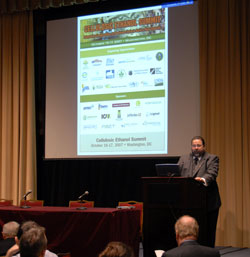 The Chairman of this year’s Cellulosic Ethanol Summit is the “Reverend of Renewable Fuels” and RFA’s own Bob Dinneen. Bob got us started and has been sort of emceeing the activities here.
The Chairman of this year’s Cellulosic Ethanol Summit is the “Reverend of Renewable Fuels” and RFA’s own Bob Dinneen. Bob got us started and has been sort of emceeing the activities here.
I sat down with him for a chat to get his perspective on cellulosic production and energy legislation. Bob says that RFA is sponsoring this event because the companies he represents are involved and that they’re looking at new developments like cellulose. He says RFA will represent ethanol and that the organization is feedstock neutral. He wants to remind people that “ethanol is ethanol is ethanol.” That there’s no good or bad ethanol.
Bob says that cellulosic is part of the present and the future of the ethanol industry. He wants people to take away from the conference that cellulosic ethanol is much closer to commercial reality than conventional wisdom would suggest. He also wants people to realize how much the oil industry is working against the development of ethanol regardless of what feedstock it’s made from. He’s also pretty confident we’ll have an energy bill by the end of the year.
You can listen to my interview with Bob here: [audio:http://www.zimmcomm.biz/ethanol/cellulosic-summit-07-dinneen.mp3]


 There will soon be a number of ethanol plants in operation in Ohio. To help them and the biodiesel industry as well, a new group has been formed called Buckeye Renewable Fuels Association. BRFA is headed up by long time corn grower leader Mike Wagner. In fact, he says the
There will soon be a number of ethanol plants in operation in Ohio. To help them and the biodiesel industry as well, a new group has been formed called Buckeye Renewable Fuels Association. BRFA is headed up by long time corn grower leader Mike Wagner. In fact, he says the  One of the people I met with here at the Cellulosic Ethanol Summit is Tim Lust, CEO of the
One of the people I met with here at the Cellulosic Ethanol Summit is Tim Lust, CEO of the  The
The 
 A Czechoslovakian-made jet has made history when it became the first jet to fly on 100 percent biodiesel. The L-29 military aircraft flew over the high desert near Reno, Nevada piloted by C.
A Czechoslovakian-made jet has made history when it became the first jet to fly on 100 percent biodiesel. The L-29 military aircraft flew over the high desert near Reno, Nevada piloted by C. The
The 
 Greg Blencoe, the CEO of Hydrogen Discoveries, Inc., an alternative energy research and development start-up company based in Oak Ridge, Tennessee, has issued a challenge to hydrogen energy skeptic Joseph Romm to debate the merits of hydrogen power.
Greg Blencoe, the CEO of Hydrogen Discoveries, Inc., an alternative energy research and development start-up company based in Oak Ridge, Tennessee, has issued a challenge to hydrogen energy skeptic Joseph Romm to debate the merits of hydrogen power. The
The